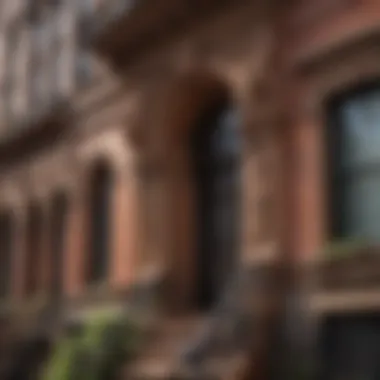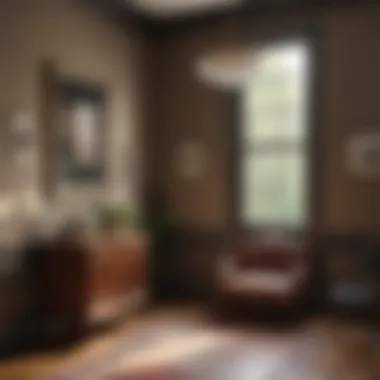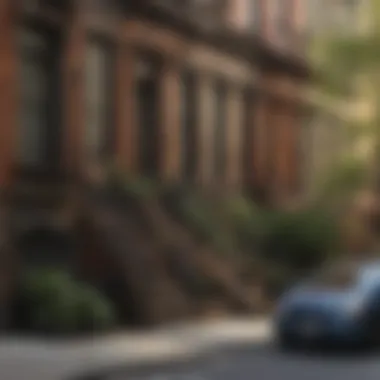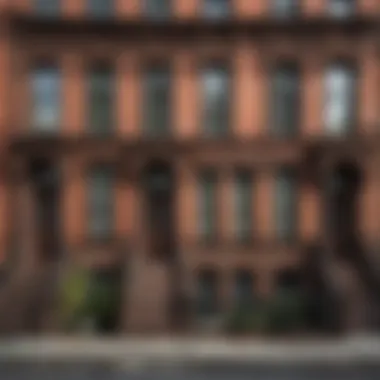Exploring Historic Brownstone Houses in Brooklyn


Intro
Brownstone houses in Brooklyn embody a distinctive architectural style that speaks volumes about the borough's history and culture. Known for their warm hues and intricate details, these structures reflect an era of urban development that shaped modern neighborhoods. As an iconic representation of Brooklyn's architectural landscape, brownstones hold unique charm and character. This article explores their significance and the communities surrounding them, appealing to homeowners, interior design enthusiasts, and real estate professionals alike.
Home Features
Architectural Marvels
Brownstone houses are often characterized by their robust facade made of brownstone, a sandstone that gives the structure its name. These buildings date back to the mid-19th century, primarily in the area of Brooklyn Heights and Prospect Park. Their layered design showcases steep stoops and large windows that invite light into spacious interiors. This architectural style includes decorative elements such as cornices, bay windows, and intricate masonry, all of which symbolize the prosperity of urban life during that time.
Unique Design Elements
The distinct design elements of brownstone houses enhance their value and disguise their age.
- Sculpted Facades: Many brownstones feature artfully carved designs above doors and windows, displaying craftsmanship that reflects the artistry of their time.
- Stoops and Entryways: The elevated stoops provide a sense of grandeur and serve as social spaces where residents can engage with their neighborhood.
- Backyards and Garden Spaces: While front lawns are rare, many brownstones have access to private gardens, offering urban dwellers a slice of nature in the heart of the city.
"Brownstones symbolize not just history but a lifestyle that embraces community, culture, and design."
Interior Design Inspirations
Color Palettes and Themes
The interior of a brownstone house often matches its historical context. Homeowners typically embrace a mix of modern and traditional decor.
- Warm Earthy Tones: Colors like terracotta, olive green, and soft beige work well to create a cozy atmosphere while maintaining the integrity of the space.
- Mix of Old and New: Incorporating antiques can beautifully complement contemporary furniture, creating a harmonious blend of style and comfort.
Furniture Arrangement Tips
Arranging furniture in a brownstone can be unique due to its typically narrow layout. Here are some tips for maximizing space:
- Define Zones: Use area rugs to create distinct living and dining areas in an open layout.
- Functional Furniture: Opt for multi-purpose furniture, like ottomans that double as storage, to utilize space more efficiently.
- Emphasize Vertical Space: Tall bookshelves and artwork can draw the eye upward, making rooms feel more spacious.
In sum, brownstone houses in Brooklyn offer much more than just living space. They are an embodiment of the city's rich history and cultural tapestry. With their architectural beauty and the communities they foster, these structures continue to allure those looking for unique homes. Whether it is the aesthetic value, interior designs, or the sense of community, brownstones remain a focal point for residents and designers alike.
Prelims to Brownstone Houses
Brooklyn's brownstone houses are more than simple structures; they are symbols of community, history, and architectural beauty. This introduction sets the stage for a detailed examination of brownstone houses, highlighting their significance not just in Brooklyn, but as part of the larger narrative of urban development in America. These iconic buildings have shaped neighborhoods and continue to influence contemporary living.
Definition and Characteristics
Brownstone houses are generally defined as multi-family residences built primarily of brown sandstone. This uniquely colored stone originates from quarries in New Jersey and other states, offering aesthetic appeal and durability. Brownstones typically feature three to four stories, marked by distinctive stoops that lead to imposing front doors. The typical characteristics of a brownstone include:
- Row House Formation: Most brownstones are arranged in row house style, contributing to the cohesive streetscapes of neighborhoods.
- Height and Proportions: These homes tend to be taller than many other types of residential buildings, providing for spacious living areas.
- Architectural Details: Intricate moldings and decorative cornices are common. These elements add character and elegance, making brownstones highly sought after in real estate markets.
Brownstone houses are not only valued for their historical significance but also for their architectural features that appeal to both homeowners and investors.
Historical Origins
The rise of brownstone houses began in the mid-19th century, parallel to New York City's expansion. They were constructed during a period of rapid urbanization when many people moved to the city for work and opportunity. The popularity of brownstones can be traced back to several key factors:
- Economic Growth: The booming economy in the late 1800s meant increased demand for housing. Brownstones provided affordable options for the working and middle class.
- Neighborhood Development: Places like Brooklyn saw a surge in residential construction, as neighborhoods were designed to accommodate growing populations. Brownstones became a popular choice.
- Cultural Significance: Many notable figures lived in these homes, adding cultural cachet. Writers, artists, and public figures frequently resided in Brooklyn's brownstones, which contributed to their reputation.
The historical context of brownstones gives additional depth to their significance today, serving as a reminder of the evolution of urban life in Brooklyn.
Architectural Features
Understanding the architectural features of brownstone houses is significant in appreciating their aesthetic and functional value. Characterized by their distinctive material and layout, brownstones convey a narrative of Brooklyn's past while also meeting the demands of modern living. This section explores specific elements, benefits, and considerations regarding architectural features that define these iconic homes.


Materials and Construction Techniques
Brownstone houses, primarily constructed from brownstone, a type of sandstone, showcase the natural beauty of this material. Brownstone became popular in the 19th century, as it was readily available in areas like New Jersey and New York. The stone's warm hues and unique textures offered a refined look for residential buildings.
In addition to brownstone itself, these structures often incorporate brick and other materials in their construction. The mix of materials depends on the region and architectural plans. The durability of brownstone makes it suitable for various climatic conditions, ensuring longevity in structure.
Moreover, construction techniques during the brownstone era involved skilled masonry. The detailed craftsmanship seen in the stone-carved elements showcases the workmanship of artisans. Notably, the use of high ceilings and spacious layouts reflects a tendency towards grandeur, allowing ample natural light to fill the interiors.
Facade Design and Detail
The facade of brownstone houses stands as a telling feature of their historical and architectural significance. Facades often exhibit a combination of elements such as elaborate cornices, detailed window carvings, and stoops that lead to main entrances. These features not only enhance the building's aesthetic but also communicate the socio-economic trends of the times.
"The unique facade styling of brownstone houses attracts both residents and tourists, embedding a sense of history into modern city life."
Decorative elements include pediments and pilasters that add to the character of these homes. The use of symmetry in window placement and doorways reflects classical influences. Additionally, many brownstones have undergone renovations that respect original designs while modernizing their function. This harmonious blend offers both legacy and contemporary living standards.
Interior Spaces
Inside a brownstone, the design elements are just as important as the exterior. Interiors typically feature high ceilings, which allow for an open, airy feeling. Traditional layouts include large rooms with interconnected spaces that flow seamlessly into one another. Crown moldings and hardwood floors accentuate the elegance within.
Each room often has large windows, providing abundant natural light throughout. This connection to the outdoors continues the aesthetic emphasis seen on the exterior. Additionally, many homeowners choose to balance historical elements with modern conveniences by integrating updated kitchen and bathroom designs.
Cultural Significance
The cultural significance of brownstone houses in Brooklyn is multi-faceted. These structures are not merely residential spaces but are also symbols of a unique heritage. They reflect the evolution of urban living in a vibrant metropolis. Brownstones encapsulate the stories of immigrant families, middle-class aspirations, and the transformations these neighborhoods have undergone over decades.
In recent years, these homes have become synonymous with community identity. Residents take pride in their local culture, which is often represented through the preservation of these architectural gems. The aesthetics of brownstones foster a sense of belonging and connection to the past. This can be observed in various community events that celebrate the history and culture specific to areas populated with brownstones.
Community Identity
Community identity is closely tied to the presence of brownstone houses. Each neighborhood boasts distinct characteristics, yet they share a common foundation in these historic homes. Families often feel a strong emotional bond to their brownstones, offering stability and continuity amidst the city's rapid changes.
The architecture serves as a backdrop for a variety of local traditions and interactions. For example, block parties and neighborhood fairs regularly occur in brownstone communities. These events reinforce social ties and celebrate the achievements of residents. The intrinsic value of these homes creates a platform for community collaboration, fostering a spirit of unity.
Brownstones also contribute to a neighborhood's economic vitality. They often attract like-minded individuals, leading to a cohesive community that can further enhance the local economy. As a result, many brownstone neighborhoods have witnessed a revitalization of businesses and an interest in maintaining cultural landmarks.
Influence on Arts and Literature
Brownstone houses have significantly influenced arts and literature. These structures have long been a source of inspiration for writers, artists, and musicians. Their architectural charm is often captured in novels, paintings, and songs that depict the essence of Brooklyn life. For instance, authors like Thomas Wolfe and V.S. Naipaul have referenced the richness of life in brownstone neighborhoods in their works.
In addition, the aesthetics of brownstones, such as their staircases, facades, and unique detailing, frequently appear in artistic expressions. Many local artists use these homes as subjects to convey the soul of their communities. This artistic representation serves to document the changing landscape of Brooklyn while celebrating its resilience.
"Brownstones are more than buildings; they are reflections of the stories, aspirations, and cultures that shape our neighborhoods."
As a result, brownstone houses play a crucial role in the artistic and literary framework of Brooklyn. They not only provide a physical space for creative endeavors but also connect the broader community through shared experiences and narratives. This influence extends beyond the local borders, making brownstones a significant aspect of the cultural heritage in American literature and art.
Preservation and Gentrification
Preservation and gentrification are crucial topics in understanding the future of brownstone houses in Brooklyn. These elements are intertwined with the social, economic, and cultural fabric of the neighborhoods where brownstones reside. Preservation focuses on maintaining the historical and architectural integrity of these structures, whereas gentrification refers to the transformation of neighborhoods through economic influx and rising property values. This dynamic raises essential questions regarding community identity, affordability, and the preservation of culture.
Efforts in Restoration
Restoration efforts are vital for maintaining the heritage of brownstone homes. In recent years, various community groups and organizations have emerged, advocating for the preservation of these unique structures. Local governments often support these movements by offering grants or tax incentives for homeowners who commit to restoration.
Common restoration practices include:
- Repairing original facades to retain aesthetic integrity.
- Reclaiming historical features, such as moldings, staircases, or fireplaces.
- Implementing eco-friendly materials and methods in renovations to honor modern sustainability goals.
These efforts they not only conserve the charm of brownstone houses but also enhance property values in the long run. They contribute to the neighborhoods’ visual landscape, preserving the historical narrative woven into the area's identity.


Effects of Gentrification
Gentrification leads to significant transformations in Brooklyn's brownstone neighborhoods. While it can stimulate economic growth, gentrification often has negative repercussions for long-standing residents. Increased property values can result in higher taxes and rent, displacing those who may not afford rising costs.
Some effects of gentrification include:
- Economic Diversification: New businesses and services may open, but they may cater mostly to wealthier newcomers, often leaving lower-income residents behind.
- Cultural Shift: As new residents move in, the cultural landscape may alter, risking the erosion of local traditions and community ties.
- Community Tension: Strain can develop between long-time residents and newcomers, creating divisions in community engagement.
"Gentrification not only transforms physical spaces but reshapes social relationships within a community."
Real estate enthusiasts should consider these factors in their assessments of brownstone investments. The balance between preserving a neighborhood's unique identity and adapting to modern demands remains a contentious issue. As the market continues to evolve, understanding the implications of preservation efforts and gentrification will be essential for anyone engaged in Brooklyn's real estate landscape.
Current Trends in Brownstone Living
The focus on current trends in brownstone living holds significant relevance in the context of this article. Brownstones, with their unique architectural charm, are adjusting to contemporary demands and preferences. It's essential to understand how these trends shape the living experience in these structures and their surrounding communities.
Modern Renovation Practices
Modern renovation practices in brownstones reflect a balance between preserving historical integrity and integrating contemporary aesthetics. Homeowners often seek innovative ways to update their spaces while maintaining the character that defines these homes. Popular renovations include:
- Open Floor Plans: Traditional brownstone layouts may feel cramped. Homeowners are knocking down non-load-bearing walls to create more spacious living areas.
- Kitchen Upgrades: Using high-end materials like quartz countertops and stainless steel appliances adds modern conveniences to the kitchen, which serves as a central gathering space.
- Smart Home Technology: Integrating smart thermostats, security systems, and lighting enhances functionality and energy efficiency. These technologies appeal to tech-savvy buyers and renters.
Interior design trends have also evolved. Many favor a minimalist approach, combining vintage elements with modern decor. This fusion respects the history of the brownstones while catering to modern tastes.
Sustainability Considerations
Sustainability considerations have become crucial in renovating brownstones. Homeowners increasingly prioritize eco-friendly materials and practices, benefiting the environment and creating energy-efficient homes. Key sustainability practices include:
- Energy-Efficient Windows: Replacing old windows with double-glazed, energy-efficient models reduces heat loss and noise pollution.
- Insulation Upgrades: Proper insulation helps maintain comfortable indoor temperatures, lowering heating and cooling costs.
- Sustainable Materials: Using reclaimed wood, bamboo, and low-VOC paints minimizes environmental impact and promotes healthier living spaces.
"Modern brownstone living is not just about style. It’s about making choices that respect both the past and the future."
The increasing interest in sustainable living among buyers had led to a market shift. Properties that feature eco-friendly renovations tend to attract more interest, thus influencing property values. Overall, current trends in brownstone living reflect a significant evolution, marrying the rich historical context of these homes with the needs and desires of contemporary residents.
Brownstone Neighborhoods
Brownstone neighborhoods in Brooklyn are not just areas defined by their stunning architecture; they are dynamic communities rich in history and culture. Each neighborhood boasts its own unique character, influenced by its residents, local businesses, and ongoing development. Understanding the significance of these neighborhoods provides a comprehensive overview of the brownstone living experience.
Prospect Heights
Prospect Heights is a neighborhood that exemplifies the quintessential Brooklyn brownstone experience. Its streets are lined with elegant brownstones, each with distinct architectural features and styles. The community is known for its diversity, welcoming a blend of families, artists, and young professionals. The presence of the Brooklyn Museum and the Brooklyn Botanic Garden enhances the cultural vibe, offering residents and visitors alike opportunities for engagement and relaxation.
The real estate market in Prospect Heights has seen notable appreciation in recent years. The addition of new amenities, parks, and public transportation options has contributed to its growing appeal. For those looking to invest in brownstones, this neighborhood presents a compelling case. The mix of historic buildings with modern conveniences makes Prospect Heights a hot spot for buyers seeking character combined with functionality.
Park Slope
Park Slope is often regarded as one of the most family-friendly neighborhoods in Brooklyn. With tree-lined streets and a community atmosphere, it embodies the charm associated with brownstone living. The neighborhood is noted for its proximity to Prospect Park, making it a favorite among outdoor enthusiasts. The architecture here ranges from Italianate to Romanesque, offering a feast for the eyes.
Cafés, boutiques, and restaurants contribute to a vibrant social scene. Moreover, Park Slope has a strong network of schools, which is highly attractive to families. As the neighborhood continues to develop, the demand for brownstones remains robust. Buyers are drawn to the spacious layouts typical of these homes which facilitate both family living and entertaining.
Brooklyn Heights
Brooklyn Heights stands out as one of the oldest residential communities in the borough. Its scenic views of Manhattan and waterfront promenade are iconic features that enhance its desirability. The neighborhood's brownstones are among the most photographed, showcasing well-preserved historic architecture that draws attention from many.
Beyond aesthetic appeal, Brooklyn Heights is known for its excellent real estate investment potential. The combination of history, education, and culture makes it a choice location for professionals and retirees alike. Close proximity to Wall Street adds to its allure, positioning Brooklyn Heights as a convenient alternative to Manhattan living.
Moreover, community events and a sense of safety further strengthen its neighborhoods identity. The real estate market remains competitive, rendering it essential for potential buyers to act swiftly when opportunities arise.


"Brooklyn Heights architects took a strong stance in maintaining the historical integrity of this neighborhood, ensuring the charm of its brownstones continues to resonate with residents and visitors."
In each of these areas, the charm of brownstone houses remains a central theme. The architectural beauty, cultural vibrancy, and community spirit offer an enriching experience for those who live there or choose to visit. Understanding these neighborhoods helps in appreciating contribute to brownstone living in Brooklyn.
Real Estate Market Analysis
The real estate market analysis of brownstone houses in Brooklyn is crucial for understanding the dynamics that shape this unique housing sector. A real estate market analysis provides insights into current trends, valuation metrics, and investment viability of these distinct residences. As Brooklyn’s brownstones are not just homes but historical masterpieces, their significance extends beyond mere aesthetics.
Market Trends and Valuations
Analyzing market trends reveals the evolving landscape of brownstone real estate. For instance, the demand for brownstones has surged due to their architectural appeal and cultural heritage. Buyers are often willing to pay a premium for properties that offer character and a sense of history.
Key trends include:
- Rising property values: Brownstone houses have seen significant appreciation over the past decade. This is attributed to their limited supply and high demand, especially in neighborhoods like Park Slope and Brooklyn Heights.
- Gentrification effects: Areas that were once undervalued are experiencing revitalization. As new residents move in, they often invest in renovations, further driving up property values.
- Interest in sustainability: Many buyers now seek out homes that have been upgraded with energy-efficient features, affecting how brownstones are valued in the market.
Considering these trends, understanding the valuation method becomes essential. Appraisals typically consider factors such as location, size, architectural features, and recent sales data of similar properties in the area.
Investment Opportunities
Investing in brownstone houses can be lucrative for experienced real estate professionals and first-time buyers. However, it also requires careful consideration of various factors. The charm of a brownstone can attract both renters and buyers, making them appealing in the rental market.
Potential investment opportunities include:
- Renovation projects: Many brownstones require updates. Investors can purchase properties under market value, renovate them, and then sell or rent them at a higher price.
- Long-term rentals: Given the demand for housing in Brooklyn, converting a brownstone into multi-family units can yield substantial rental income.
- Short-term rentals: With the rise of platforms like Airbnb, some homeowners capitalize on tourism, providing weekend or short-term lodging in these historic homes.
Impact of Technology on Brownstone Living
The integration of technology into brownstone living is reshaping the way residents experience their homes. This section emphasizes the significance of modern advancements in enhancing comfort, functionality, and overall quality of life. As urban environments become more competitive, these technologies not only add convenience but also play a vital role in sustainable living practices.
Smart Home Integrations
Smart home technology has become increasingly popular among brownstone residents. Devices such as smart thermostats, lighting systems, and security cameras offer practicality and efficiency. Homeowners can remotely control their environment, providing an unparalleled level of comfort.
- Smart Thermostats: These devices learn residents’ habits and adjust heating and cooling accordingly, optimizing energy usage. Brands like Nest and Ecobee are leaders in this area, offering energy-saving features that appeal to eco-conscious homeowners.
- Lighting Solutions: Smart bulbs can be controlled via a mobile app, allowing inhabitants to adjust brightness and colors to match their mood or time of day. Phillips Hue is a well-known option in this category.
- Security Systems: Advanced security options, including video doorbells from Ring and surveillance cameras, enhance peace of mind for residents.
Integration of these technologies not only maximizes residential comfort but also aids in reducing energy costs. Furthermore, it enhances property value as potential buyers are often drawn to homes equipped with modern conveniences.
Virtual Tours and Marketing
The emergence of technology has transformed how real estate is marketed. In the context of brownstones, virtual tours provide a dynamic way for potential buyers to explore properties without necessitating an in-person visit.
- Real Estate Platforms: Websites like Zillow and Realtor.com use sophisticated video technology to showcase homes. This technology allows viewers to get a feel for a space, making the real estate process more efficient.
- 360-Degree Tours: Several agencies now offer immersive experiences that let potential buyers navigate rooms as if they were inside the property. This level of engagement greatly enhances interest in a listing.
"Virtual tours utilize technology to captivate buyers, breaking geographical barriers and offering an inside look at homes."
This approach is particularly useful during times when travel restrictions or health concerns might hinder traditional showings. The effectiveness of virtual marketing has made it a fundamental tool in the real estate industry.
Technology has become integral to brownstone living, offering innovative solutions that address the needs of modern residents. As homeowners increasingly prioritize convenience and efficiency, the influence of technology on their living environments will likely continue to grow.
Closure
The exploration of brownstone houses in Brooklyn reveals much about the architectural history and cultural landscape of this iconic borough. Understanding the significance of these structures is crucial for various stakeholders, including homeowners, designers, and real estate investors. Brownstones represent a unique blend of aesthetics, functionality, and community values that continue to evolve.
The Future of Brownstones
As we look to the future, brownstone homes face both challenges and opportunities. The preservation of their historic character is paramount. Owners and communities must engage in conscientious restoration practices to maintain the charm that defines these homes. Additionally, modern renovation must respect the original design while accommodating contemporary living needs.
The integration of smart home technologies is also changing the way people experience brownstone living. Features such as smart thermostats, advanced security systems, and energy-efficient appliances not only enhance comfort but also improve sustainability. This shift toward technology must balance with preserving the aesthetic qualities that make brownstones desirable.
Moreover, the gentrification of neighborhoods adds complexity to the future of brownstones. While economic development can boost local economies, it may also threaten the cultural fabric of the community. Hence, mindful development is crucial.
The future of brownstones must harmonize heritage with innovation, ensuring these historic homes continue to thrive in urban life.
In summary, the future of brownstones in Brooklyn is a tapestry woven from historical respect, modern innovation, and the dynamic needs of the community. Stakeholders are required to approach brownstone living with thoughtfulness and foresight.



